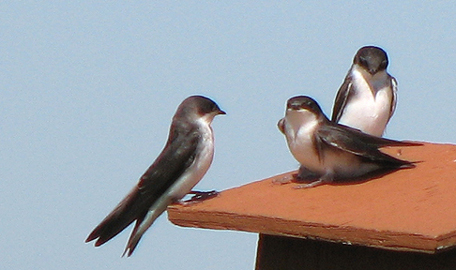
At Your Boxes:
Most Tree Swallow nests are empty now, although a few boxes where replacements or takeovers occurred may still hold late young being tended by adults. Maybe you’ll take this opportunity to start getting your nesting result records ready for submission to NestWatch, for the US, or Project NestWatch, for Canada. However, since some of your former nestlings, now fully independent juvenile Tree Swallows, may linger around the project for a week or more if the foraging is good, this is the best time to observe their behavior.
Concepts:
How can you tell juvenile Tree Swallows from adults?
- Juveniles that have recently fledged, like the ones above, have sooty gray-brown upper bodies, wings, and tails, with no traces of iridescent blue or green.
- A few juvenile Tree Swallows may show a faint breast band (see below).
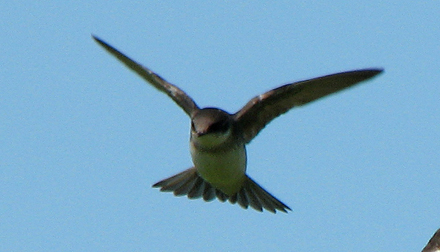
- Don’t mistake these juvenile Tree Swallows for Bank Swallows, whose breast band is much darker and more solid.
- Compare the solid, well-defined band on the Bank Swallow below left to the faint one on the Tree Swallow above.
- The bird below right is a more typical juvenile Tree Swallow with no band.
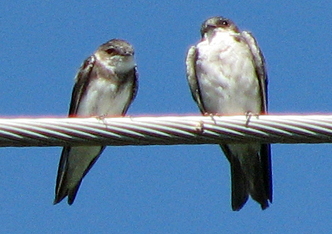
- Juveniles weigh about the same as adults but their shorter, rounder-tipped wings and tails make them appear smaller and chunkier.
- Juvenile flight is a bit slower, weaker, and more “fluttery” than adult flight.
- If viewed up close some recently fledged juveniles may still show traces of yellow flanges at the corners of their mouths, as in the photo below by Len Blumin.
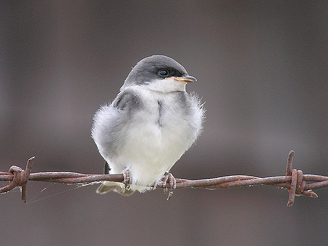
When will juveniles get their adult Tree Swallow plumage?
- Juvenile molt to adult plumage begins a few weeks after fledging.
- Molt in Tree Swallows is a gradual process, extending over several months.
- Surviving juveniles will complete feather replacement by late autumn.
- Juvenile males will acquire the blue-green iridescent upper body possessed by all after-hatch-year (AHY) males.
- Juvenile females will acquire the brownish-green upper body plumage that distinguishes second-year (SY) females from older ASY females.
- For more on plumage sequences see Sexing and Aging Tree Swallows.
Where have the adults that have finished nesting gone?
- Soon after their nestlings fledge parent Tree Swallows tend to move to large wetlands, where they join other Tree Swallows to form post-breeding foraging and roosting flocks.
- A few scruffy adults may still hang around your project sunning and preening.
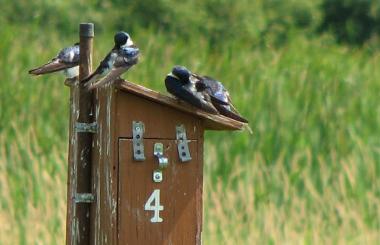
- Check these lingering adults for the beginning stages of molt, which usually starts by early July.
- As they fly overhead look for notches in the trailing edges of adults’ wings and tails where their flight feathers have begun to be lost, and new ones, still short, are growing in.
While independent juvenile Tree Swallows hang around, what are they doing?
- Juveniles may join remaining adults hunting for food over fields and wetlands.
- Some may beg at passing adults, trying to get a free meal.
- When not foraging they often perch with adults in groups on wires and trees, resting and preening.

- They may land and sun themselves on roads, beaches, roofs, fields and other sunny, warm surfaces.
- Juveniles frequently approach nest boxes, fluttering around, perching on, and even entering them, especially boxes that still contain living nestlings.
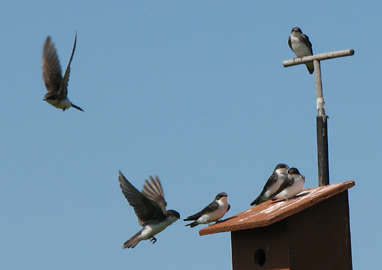
Why do independent juvenile Tree Swallows congregate at boxes that still contain nestlings?
- We aren’t sure.
- It’s been suggested they’re “scouting” potential nest sites for next year, but there’s no evidence supporting this.
- Some may be trying to mooch a free meal from resident adults.
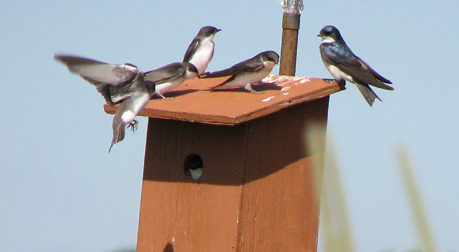
- They are not “helping out.” Their presence may actually interfere with parents trying to feed nestlings in late nests.
- If you look closely at the photos above and below you’ll see juveniles interfering with an adult, preventing it from delivering food to its own small young inside.
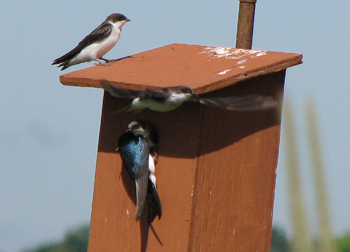
Question for the next Topic: Tree Swallow Flocks and Migration
- What happens after nesting is over?
- Where will your the swallows go next and what do they do there?
- Why do birds form flocks?
- Why do Tree Swallows migrate?
———————————————————————————
Home: Tree Swallow Nest Box Projects
Creating Tree Swallow Nest Box Projects
Spring Return
Nesting Season Behavior
Song and Calls
Nest Site Claiming
Pair Formation
Nest Building
Bird Flight
Mating and Paternity
Diary of One Season at Salmon Creek
Monitoring Nest Boxes and Keeping Records
Making Box Checks Keeping Box Records Control Sheets Season Summaries Print Sheets
Banding Your Tree Swallows Banding Adults Banding Nestlings
Tree Swallows in Research Research Bibliography Glossary of Terms